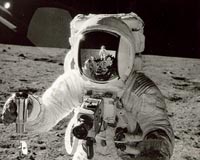 |
Washington (AFP) Oct 9, 2009 The United States successfully blasted a rocket into the moon on Friday, slamming it into a crater near the lunar south pole in a bid to discover water, US space agency NASA said. No light flash was visible in the thermal images broadcast on NASA television, as the 2.3-tonne rocket impacted the Cabeus crater at 1131 GMT. A second shepherding spacecraft flew through the debris plume, collecting and relaying key data back to Earth before it too plowed into the lunar surface, according to the US space agency. The LCROSS mission is hoping to uncover whether there is water or ice below the moon's surface that could be used by astronauts on future space missions.
earlier related report Conspiracy theories aside -- a Do Not Bomb the Moon website has been campaigning against the move -- there is no actual bomb, but the US space agency's unmanned LCROSS satellite and heavier Centaur upper-stage rocket will still leave huge impacts where NASA hopes to find evidence of water or ice. At 1130 GMT, the rocket and four minutes later the "shepherding spacecraft" will slam into the Cabeus crater floor near the moon's south pole at 5,600 miles (9,000 kilometers) per hour to kick up a plume of lunar dirt to an altitude of about 6.2 miles (10 kilometers). The flash that follows the impact will last about 30 seconds. Cameras mounted on the 1,965-pound (891-kilogram) shepherding spacecraft will beam live footage of the initial impact as the craft flies through the debris plume, collecting and relaying key data back to Earth before it too plow's into the moon. The Lunar Crater Observation and Sensing Satellite (LCROSS) separated from the Centaur rocket at 0150 GMT Friday in preparation for the pair of impacts. "We don't anticipate anything about presence or absence of water immediately. It's going to take us some time," cautioned Anthony Colaprete, project scientist and principal investigator for the 79-million-dollar LCROSS mission, which is also the first preparatory mission of the Constellation program that aims to send Americans back to the moon by 2020. Colaprete projected it would take several days for analysts to evaluate the data and several weeks to determine whether and how much hydrogen-bearing compounds were found. For those hoping to catch a bare-eyed glimpse of the impact, the scientist had sad news. "It's not going to be a grand spectacle that you can go outside in your back yard and see with your bare eyes or even a good binoculars. It's going to be too faint," said Colaprete. More powerful telescopes around the world and also the Hubble Space Telescope will nevertheless get a good view as they focus on the giant cloud of debris. NASA scientists will be looking at what spews out after 350 tonnes of debris is ejected from the cold, dark Cabeus crater, staking its hopes on water in the form of ice. The crater is 62 miles (100 km) across and between 1.6 and 2.5 miles (2.5 to four km) deep. "We're hunting for how water ice was stored and trapped in these permanently shadowed areas over billions of years and we want to find out how much there is," explained Peter Schultz, a professor of geological sciences at Brown University who helped design the mission. The mission comes just two weeks after India hailed the discovery of water on the moon with its Chandrayaan-1 satellite mission in partnership with NASA. Scientists had previously theorized that, except for the possibility of ice at the bottom of craters, the moon was totally dry. Finding water on Earth's natural satellite would be a major breakthrough in space exploration and pave the way toward future lunar bases for drinking water or fuel, or even man living on another planet. "This could be the place that we could go to mine water for a permanent lunar base," said Schultz. "It tells us something about how water was delivered to the moon and other planets in a sort of cosmic rain, meaning impacts from comets over eons." But much uncertainty surrounds NASA's future dealings with the moon, as a key review panel appointed by President Barack Obama's administration said existing budgets bar a return to the cold outpost before 2020. The last manned mission to the moon, Apollo 17, took place in 1972. Share This Article With Planet Earth
Related Links Mars News and Information at MarsDaily.com Lunar Dreams and more
 Microwaving Water From Moondust
Microwaving Water From MoondustHuntsville AL (SPX) Oct 08, 2009 NASA is figuring out how to make water from moondust. Sounds like magic? "No magic--" says Ed Ethridge of NASA's Marshall Space Flight Center "-- just microwaves. We're showing how microwaves can extract water from moondust by heating it from the inside out." The recent discovery of water on the Moon's surface has inspired researchers like Ethridge to rev up the development of technologies ... read more |
|
| The content herein, unless otherwise known to be public domain, are Copyright 1995-2009 - SpaceDaily. AFP and UPI Wire Stories are copyright Agence France-Presse and United Press International. ESA Portal Reports are copyright European Space Agency. All NASA sourced material is public domain. Additional copyrights may apply in whole or part to other bona fide parties. Advertising does not imply endorsement,agreement or approval of any opinions, statements or information provided by SpaceDaily on any Web page published or hosted by SpaceDaily. Privacy Statement |